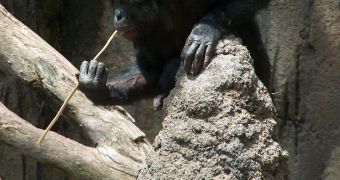A group of researchers publishes the conclusions of a new study on bonobos (pan paniscus), that shows the primates tend to use their heads to prevent others from performing something bad. Video evidence captures the bonobos as they shake their heads as to say “no,” when they see others attempting to perform undesirable actions. The behavior has also been noticed in interactions between mother and offspring, and the researchers say that head shaking has never before been seen used in this manner.
The investigation was conducted at the Leipzig Zoo, in Germany, where investigators at the Max Planck Institute for Evolutionary Anthropology set up cameras to look at the behavior of the primates. They noticed that the animals shook their heads in disapproval whenever they saw members of the group performing undesirable actions. The gesture resembles the one humans make in the same circumstances to a great extent. The primates also move their heads from side to side in a specific algorithm, which clearly conveys dissatisfaction with other bonobos' actions, PhysOrg reports.
Mothers were noticed performing this gesture when their offspring played with their food, rather than eating it. Common chimpanzees (Pan troglodytes) have been found to perform head gestures as well, for conveying a variety of social messages, as have other primates too. But the bonobo is the only animal that uses the side-to-side head gesture in two specific circumstances – either to invite other group members to play, or to express their disapproval. The researchers decided to publish details of their findings after having noticed the head gesture being performed by 4 different bonobos, on 13 individual occasions.
In a paper describing the findings, which appears in the latest issue of the esteemed scientific journal Primates, the MPI team hypothesizes that the reason bonobos exhibit this wide array of head gestures may be the way in which their societies are set up. Their groups are egalitarian, and feature very complex social structures. However, hierarchies are a lot less pronounced than they are in other groups of great apes, the researchers say. In fact, numerous behaviors that the bonobo applies are aimed at conflict resolution, and on avoiding disturbances. The human-like head gesture may also be a weapon in this arsenal of tactics.

 14 DAY TRIAL //
14 DAY TRIAL //